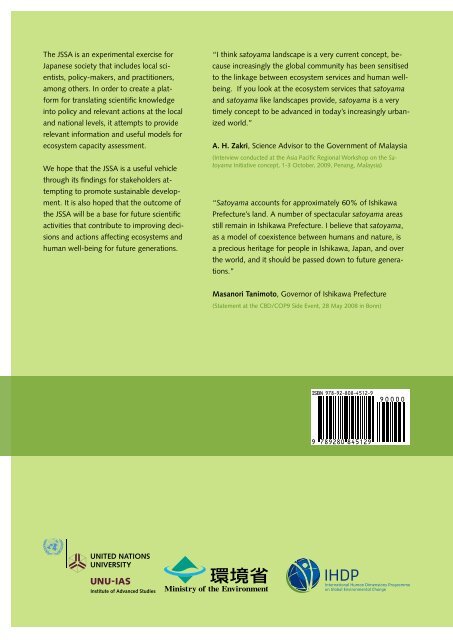Satoyama-Satoumi Ecosystems and Human Well-Being - UNU-IAS ...
Satoyama-Satoumi Ecosystems and Human Well-Being - UNU-IAS ...
Satoyama-Satoumi Ecosystems and Human Well-Being - UNU-IAS ...
You also want an ePaper? Increase the reach of your titles
YUMPU automatically turns print PDFs into web optimized ePapers that Google loves.
The JSSA is an experimental exercise for<br />
Japanese society that includes local scientists,<br />
policy-makers, <strong>and</strong> practitioners,<br />
among others. In order to create a platform<br />
for translating scientific knowledge<br />
into policy <strong>and</strong> relevant actions at the local<br />
<strong>and</strong> national levels, it attempts to provide<br />
relevant information <strong>and</strong> useful models for<br />
ecosystem capacity assessment.<br />
We hope that the JSSA is a useful vehicle<br />
through its findings for stakeholders attempting<br />
to promote sustainable development.<br />
It is also hoped that the outcome of<br />
the JSSA will be a base for future scientific<br />
activities that contribute to improving decisions<br />
<strong>and</strong> actions affecting ecosystems <strong>and</strong><br />
human well-being for future generations.<br />
“I think satoyama l<strong>and</strong>scape is a very current concept, because<br />
increasingly the global community has been sensitised<br />
to the linkage between ecosystem services <strong>and</strong> human wellbeing.<br />
If you look at the ecosystem services that satoyama<br />
<strong>and</strong> satoyama like l<strong>and</strong>scapes provide, satoyama is a very<br />
timely concept to be advanced in today’s increasingly urbanized<br />
world.”<br />
A. H. Zakri, Science Advisor to the Government of Malaysia<br />
(Interview conducted at the Asia Pacific Regional Workshop on the <strong>Satoyama</strong><br />
Initiative concept, 1-3 October, 2009, Penang, Malaysia)<br />
“<strong>Satoyama</strong> accounts for approximately 60% of Ishikawa<br />
Prefecture’s l<strong>and</strong>. A number of spectacular satoyama areas<br />
still remain in Ishikawa Prefecture. I believe that satoyama,<br />
as a model of coexistence between humans <strong>and</strong> nature, is<br />
a precious heritage for people in Ishikawa, Japan, <strong>and</strong> over<br />
the world, <strong>and</strong> it should be passed down to future generations.”<br />
Masanori Tanimoto, Governor of Ishikawa Prefecture<br />
(Statement at the CBD/COP9 Side Event, 28 May 2008 in Bonn)
















